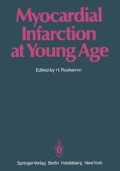Abstract
In various prospective studies [1–7] a sedentary overweight subject had an increased risk of new coronary events ranging up to 1.5. These studies have been done by occupational stratification into sedentary, active, strenuous, and very strenuous levels. A number of studies have been attempted in primary prevention of coronary artery disease by multiple risk factor intervention trials, and early results are beginning to appear [8, 9]. A number of secondary prevention trials are under way and have shown a consistent reduction in mortality from recurrent infarction in the active exercising subjects, when compared to less active controls, and a significant change in the incidence of new coronary events [10–14].
Access this chapter
Tax calculation will be finalised at checkout
Purchases are for personal use only
Preview
Unable to display preview. Download preview PDF.
References
Kannel WB, Dawber TR, Kagan M etal. (1961) Factors or risk in the development of heart disease: Six-year follow-up experience. The Framingham study. Ann Intern Med 55: 33–50
Kannel WB, Sorlie P, McNamara PM (1971) The relation of physical activity to the risk of coronary disease: The Framingham study. In: Clarksen OA, Malborg AO (eds) Coronary heart disease and physical fitness. University Park Press, Baltimore, pp 256–272
Chapman JM, Massey FJ (1964) The inter-relationship of serum cholesterol, hypertension, body weight and risk of coronary artery disease: Results of the first ten-year follow-up in Los Angeles Heart Study. J Chronic Dis 17: 922–999
Epstein FH, Ostrander LD, Johnson BC et al. (1965) Epidemiological studies of cardiovascular disease in a total community - Tecumseh, Michigan. Ann Intern Med 62: 1170–1187
Morris JN, Adams C, Chave SPW etal. (1973) Vigorous exercise in leisure time and the incidence of coronary heart disease. Lancet 1: 333–339
Paffenbarger RS Jr (1975) Work activity and coronary heart mortality. N Engl J Med 292: 545–550
Rabkin DE, Mathewson AL, Hsu P (1977) Relation of body weight to development of ischemic heart disease in a cohort of young North American men after a 26-year observation period. The Manitoba study. Am J Cardiol 39: 452–550
Farrand ME et al. (1980) Nutrition in the multiple risk factor intervention trial (MRFIT). J Am Diet Assoc 76 /4: 347–351
Hjermann I (1980) Smoking and diet intervention in healthy coronary high-risk men. Methods plus 5-year follow-up of risk factors in a randomized trial. The Oslo study. J Oslo City Hosp 30 /1: 3–17
Hellerstein HJ, Horsten TR, Goldberg A et al. (1967) The influence of active conditioning upon subjects with coronary artery disease. Can Med Assoc J 96: 901–903
Brunner D, Meshulman N (1969) Prevention of recurrent myocardial infarction by physical exercise. Isr J Med Sci 5: 783–785
The National exercise and Heart Disease Project Staff (1980) Effects of a prescribed supervised exercise program on mortality and cardiovascular morbidity in myocardial infarction subjects: a randomized clinical trial. Cardiovas Dis Epidemiol Newsletter 28: 55
Kallio V, Hamalainen H, Hakkila J, Luurila OJ (1979) Reduction in sudden deaths by a multifactiorial intervention programme after acute myocardial infarction. Lancet II: 1091
Shephard RJ (1979) Recurrence of myocardial infarction in an exercising population. Br Heart J 42: 133
Selvester R, Camp J, Sanmarco M (1978) Effects of exercise training on progression of documented coronary arteriosclerosis in men. Ann NY Acad Sci 301: 495
Author information
Authors and Affiliations
Editor information
Editors and Affiliations
Rights and permissions
Copyright information
© 1981 Springer-Verlag Berlin Heidelberg
About this paper
Cite this paper
Selvester, R., Sanmarco, M., Blessey, R. (1981). Risk Reduction and Coronary Progression and Regression in Humans. In: Roskamm, H. (eds) Myocardial Infarction at Young Age. Springer, Berlin, Heidelberg. https://doi.org/10.1007/978-3-642-68294-0_28
Download citation
DOI: https://doi.org/10.1007/978-3-642-68294-0_28
Publisher Name: Springer, Berlin, Heidelberg
Print ISBN: 978-3-642-68296-4
Online ISBN: 978-3-642-68294-0
eBook Packages: Springer Book Archive

